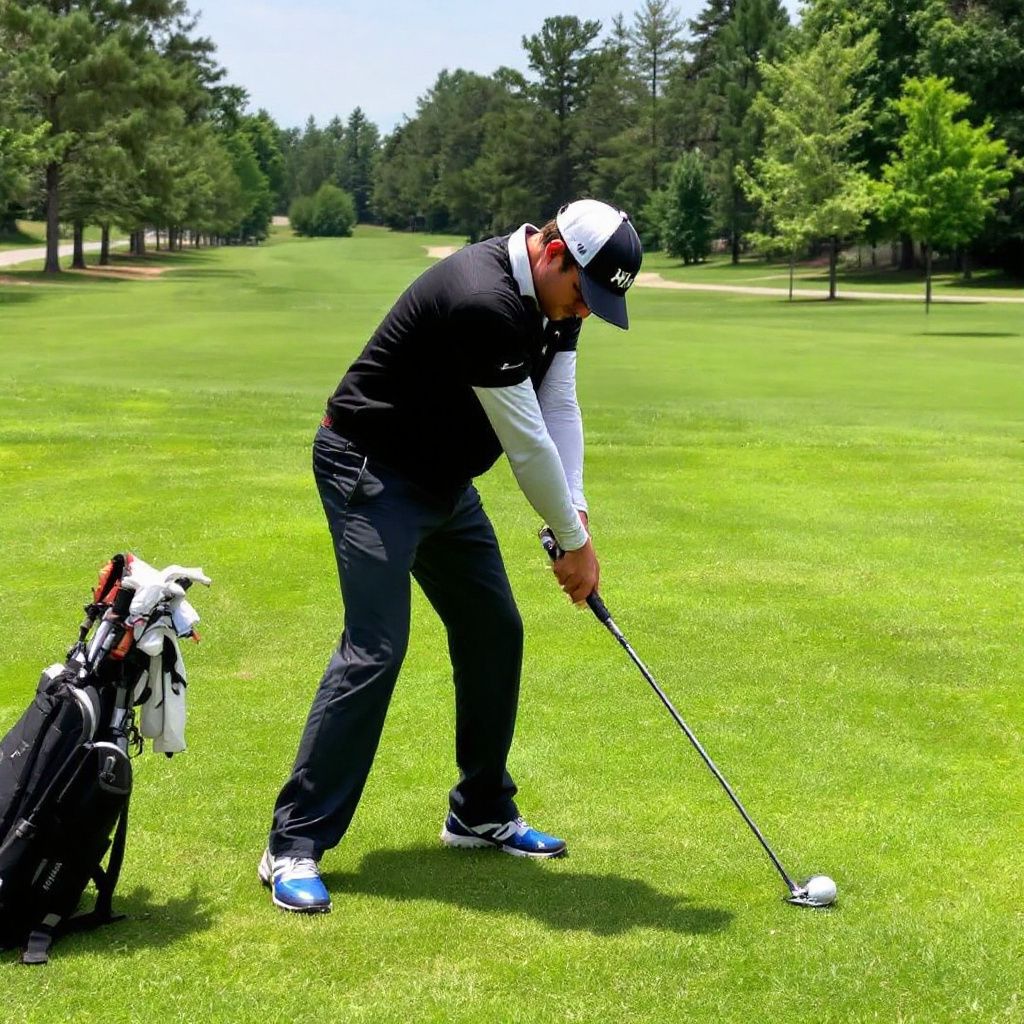Imagine this: you’re standing on the 17th tee, about to take on one of the toughest holes on the course. You’ve been struggling with your swing all day, and you know that a smooth, consistent swing is the key to salvaging your game. But what exactly makes a great golf swing? Is it the grip, the stance, or the shift from backswing to downswing? As you take your shot, you can’t help but wonder what secrets the pros use to dominate the course. Let’s explore the best golf swing tips to take your game to the next level – and find out what’s been holding you back.
Key Takeaways
• Maintain a consistent grip, with hands positioned equally on the club and wrists aligned for a smooth swing.
• Focus on a balanced stance, with feet shoulder-width apart, knees slightly bent, and weight evenly distributed.
• Master the backswing by rotating shoulders, uncocking wrists, and maintaining spine angle for a powerful downswing.
• Practice a smooth transition to the downswing, releasing stored energy and focusing on triggers for a consistent tempo.
• Develop a consistent rhythm by focusing on the sequence of movements and practicing with a slower tempo to build muscle memory.
Grip Fundamentals for Beginners
Establish a solid foundation for your golf swing by mastering the basics of grip fundamentals, as a proper grip is essential for generating power, control, and consistency in your game. You’ll want to explore different grip styles, such as the neutral, strong, or weak grip, to find what works best for you.
Proper hand positioning is essential, with your hands placed equally on the club. Pay attention to finger placement, ensuring your fingers wrap around the club without tension. Wrist alignment is also pivotal, as it affects the clubface’s direction. Aim for a neutral wrist alignment, avoiding any twisting or turning.
Palm pressure is another key aspect, as excessive pressure can lead to a loss of control. Focus on applying even pressure with both palms. Thumb control is equally important, as it helps maintain a consistent grip pressure.
Forearm rotation is essential for generating power and control. Practice rotating your forearms to develop a smooth, consistent swing. Finally, grip pressure is critical, as it affects the overall feel of your swing. Aim for a light grip pressure, avoiding any squeezing or tension.

Stance and Posture Essentials
As you prepare to swing, stand behind the ball with your feet shoulder-width apart, with your weight evenly distributed between both feet, and your knees slightly bent. This is the foundation of a solid stance, allowing you to maintain balance and generate power throughout your swing.
Proper footwork is essential, ensuring you’re stable and grounded, with your weight evenly distributed between both feet. This athletic base enables you to rotate and generate torque, creating a more powerful swing.
Maintaining spinal alignment is essential, keeping your spine straight and your posture upright. This allows you to maintain a consistent swing plane and generates more power.
Core engagement is also imperative, as it helps you rotate and generate torque. Engage your core muscles by drawing your belly button towards your spine, creating a strong, stable base.
Balanced weight distribution is key, keeping your weight evenly distributed between both feet. Avoid leaning forward or backward, as this can throw off your balance and disrupt your swing.
Ball Positioning Strategies
You position the ball just forward of the center of your stance, about 2-3 inches inside your left shoulder, to optimize your swing plane and generate more power. This ball positioning strategy allows you to maintain a consistent swing plane and generate more power in your shots.
To better understand the importance of ball positioning, let’s break down the key considerations:
| Ball Alignment | Target Line |
|---|---|
| The ball should be aligned parallel to your target line, promoting a straight shot. | The target line is the direction you want the ball to travel, taking into account any obstacles or hazards. |
| The ball should be positioned slightly forward of center to promote a more aggressive swing plane. | Keep your target line in mind when adjusting your ball position to maintain a consistent swing. |
| Experiment with different ball positions to find what works best for your unique swing. | Practice adjusting your ball position to develop muscle memory and improve your overall game.
Mastering the Backswing
By rotating your shoulders and uncocking your wrists, you’re able to generate torque and build power in your backswing, setting yourself up for a more explosive downswing.
This is where the magic happens, and mastering the backswing is vital to tapping your full potential on the course.
To improve your backswing, try incorporating backswing drills into your practice routine. Focus on maintaining a consistent swing sequence, starting with torso rotation, which sets the tone for the rest of your swing.
Pay attention to your spine angle, keeping it straight and stable as you rotate.
As you swing back, allow your shoulders to tilt and your arms to extend, keeping your elbows slightly bent.
This will help you maintain control and generate power. Don’t forget to cock your wrists, storing energy that will be released in the downswing.
Regular practice of this sequence is necessary to develop muscle memory and consistency.
Remember, the key to a powerful backswing is generating torque and storing energy, which will be released in the downswing.
Transitioning to Downswing
In shifting to the downswing, your body unwinds, releasing the stored energy from the backswing, and your hands and arms take over, redirecting the club’s momentum towards the ball.
This shift is pivotal, as it sets the stage for a powerful and accurate shot.
To initiate the downswing, focus on your downswing triggers, such as the uncocking of your wrists and the hinging of your hips.
These triggers will help you maintain a smooth acceleration, ensuring a consistent and controlled swing.
As you begin the downswing, keep your eyes fixed on the ball and maintain a consistent posture.
Avoid swaying or leaning, as this can disrupt your balance and timing.
Instead, focus on rotating your body, allowing your hands and arms to follow naturally.
This will help you generate power and speed, while maintaining control over the club.
Hip Rotation and Power
Three-quarters of a golfer’s power originates from hip rotation, which fuels the downswing and enables a more explosive shot.
You see, hip rotation is the key to tapping into your full potential on the course. It’s what separates the pros from the amateurs.
To tap into this power, you need to focus on generating torque through your core engagement and pelvic tilt. This will help you load your hips and create a dynamic movement that transfers power to your upper body.
Focus on rotation speed: A faster rotation speed will result in more power and distance. Practice rotating your hips quickly and smoothly to generate maximum torque.
Engage your lower body strength: Your legs and glutes are the engines that drive your swing. Make sure to engage them fully to generate maximum power.
Maintain a dynamic movement: Avoid stiffness and rigidity in your swing. Instead, focus on creating a fluid, dynamic movement that transfers power from your hips to your upper body.
Controlling Club Head Speed
As you work on controlling your club head speed, remember that a smooth tempo is essential.
You’ll want to focus on maintaining a consistent pace throughout your swing, avoiding sudden bursts of speed that can throw off your entire game.
Smooth Tempo Matters
Maintaining a smooth tempo is essential in controlling club head speed, which in turn helps you achieve a more consistent and accurate golf swing. By focusing on your rhythm awareness, you’ll be able to develop a tempo that works for you. This means avoiding tempo variation, which can throw off your entire swing.
To achieve a smooth tempo, try the following:
- Practice with a metronome: This will help you develop a consistent rhythm and timing in your swing.
- Focus on your shift: The change from backswing to downswing is vital in maintaining a smooth tempo. Practice this section of your swing to guarantee a seamless handoff.
- Slow down: Many golfers tend to rush their swing, which can lead to a loss of control. Focus on slowing down your tempo to achieve a more consistent swing.
Balance Is Key
Controlling club head speed is crucial to a consistent golf swing, and finding the perfect balance between power and control is essential to mastering it.
You need to maintain a stable foundation, engaging your core and keeping your weight evenly distributed between both feet. This will help you maintain your center gravity, ensuring a smooth swing.
As you swing, focus on your body awareness, keeping your posture corrected and your poise maintained. This will allow you to generate power without sacrificing control.
Remember to keep your weight transfer smooth, avoiding any sudden shifts that can throw off your balance. By doing so, you’ll be able to control your club head speed, generating the perfect amount of power and control.
Practice your swing regularly, focusing on your weight distribution and core engagement. With time and patience, you’ll develop a consistent swing that will take your game to the next level.
Understanding Swing Plane Basics
As you work on understanding swing plane basics, you’ll want to focus on identifying the angles of your swing plane, which will help you develop a more consistent and powerful swing.
You’ll need to master the timing of shifting between these planes to facilitate a smooth shift from backswing to downswing.
Identifying Swing Plane Angles
Determine your swing plane angle by observing the trajectory of your clubhead as it approaches the ball, focusing on the shallow, ascending blow that characterizes a well-executed golf swing. This is essential in understanding your swing plane basics.
To identify your swing plane angles, you’ll need to analyze your swing plane and work on specific drills to improve your game.
Conduct a plane analysis: Record your swing from a face-on angle to get a clear view of your swing plane. Analyze the video to determine your swing plane angle and identify areas for improvement.
Practice angle drills: Try swinging with a more vertical or horizontal plane to develop a better understanding of how it affects your ball-striking. This will help you find a comfortable swing plane angle that suits your game.
Experiment with different swings: Try out different swing styles, such as a draw or fade, to develop a better understanding of how to manipulate your swing plane angle to achieve the desired shot shape.
Mastering Plane Shift Timing
Mastering the timing of your plane shift is crucial, as it allows you to seamlessly shift between backswing and downswing, generating more power and consistency in your golf swing. To achieve this, focus on executing precise Plane Shift Drills, which will help you develop a smooth conversion between the two phases of your swing.
| Timing Cues | Drill Description |
|---|---|
| Start of backswing | Begin shifting your weight onto your back foot, hinging your hips |
| Top of backswing | Pause, then initiate the downswing by re-hinging your hips |
| Start of downswing | Unweight your back foot, transferring weight to your front foot |
| Impact | Keep your hands and arms relaxed, letting the clubhead speed generate power
Body Alignment and Aim
What’s the secret to hitting consistent shots, and how do you guarantee your body is aligned properly with your target? It all starts with body alignment and aim. When you’re lined up correctly, you’ll be amazed at how much more consistent your shots become.
To achieve a square stance, focus on the following:
- Feet parallel to the target line: Make sure your feet are pointing directly at the target, with your weight evenly distributed between both feet.
- Shoulders aligned with the target: Keep your shoulders relaxed and in line with the target, avoiding any twisting or turning.
- Eyes on the target: Focus your gaze directly on the target, keeping your eyes fixed on the spot where you want the ball to land.
Managing Slice and Hook Shots
As you step up to the tee, you’ve likely encountered the frustration of watching your ball veer sharply off course, succumbing to the nemesis of slice or hook shots.
These wayward shots can be corrected, and it starts with understanding the root cause.
Slice correction begins with adjusting your swing path. If you’re hitting slices, your club face is likely open at impact, resulting in a higher spin rate and a curved ball flight.
To correct this, try rotating your club face slightly closed at address, and focus on a more neutral swing angle. This will help reduce the spin rate and straighten out your flight pattern.
On the other hand, hook prevention requires a different approach.
Hooks often result from a closed club face at impact, causing the ball to curve sharply in the opposite direction.
To prevent hooks, try opening your club face slightly at address, and focus on a more shallow swing path. This will help reduce the spin rate and promote a more piercing ball flight.
Chipping and Pitching Techniques
When it comes to chipping and pitching, you’ll want to focus on three key elements to improve your short game.
First, you’ll need to master the correct grip and stance alignment, ensuring you’re set up for success.
Next, you’ll learn the secrets of ball positioning and how to control your swing speeds to get the desired outcome.
Grip and Stance Alignment
Establishing a consistent grip and stance alignment is essential for chipping and pitching, as it sets the foundation for a reliable and repeatable swing. You want to build a strong athletic foundation, with a golf posture that allows you to maintain balance and generate power.
To achieve this, focus on the following key elements:
- Maintain a neutral grip pressure: Avoid squeezing the club too tightly, as this can cause tension in your arms and shoulders.
- Keep your weight evenly distributed: Make sure your weight is evenly distributed between both feet, with a slight bias towards the balls of your feet.
- Align your shoulders and hips: Keep your shoulders and hips parallel to the target line, guaranteeing your body is aligned with the direction you want the ball to go.
Ball Positioning Secrets
Understanding ball positioning secrets is vital for mastering chipping and pitching techniques. You want to position the ball in the correct spot to maintain a consistent swing.
When it comes to ball alignment, you should place the ball just forward of the center of your stance, with your feet shoulder-width apart. This will help you maintain a consistent swing path and guarantee a solid strike.
For target focus, identify your target line and align your body accordingly, keeping your eyes on the target throughout the swing.
Ball placement is critical, as it affects the trajectory and spin of your shot. Experiment with different placements to find what works best for you.
Finally, consider your swing path, taking into account the angle of attack and the club’s loft. By mastering these ball positioning secrets, you’ll be well on your way to becoming a chipping and pitching pro.
Controlled Swing Speeds
Mastering controlled swing speeds is essential for chipping and pitching success, as it allows you to manipulate trajectory, spin, and distance with precision.
By developing a consistent swing tempo, you’ll be able to dial in your shots with confidence.
To achieve controlled swing speeds, focus on the following:
- Set your speed limits: Identify the maximum speed you can swing and still maintain control, then work within that range.
- Use a swing meter: This tool will help you measure and adjust your swing speed to achieve the desired outcome.
- Practice with purpose: Focus on making precise, controlled swings rather than trying to hit the ball as hard as possible.
Mastering Bunker Shot Escapes
When your ball lands in a bunker, it’s essential that you assess the lie, taking note of the sand’s depth and the ball’s proximity to the bunker’s face, to determine the best escape strategy.
You’ll want to carefully examine the bunker’s slope, the sand’s firmness, and the ball’s position relative to the lip. This assessment will help you decide on the right club, stance, and swing technique to use.
In terms of bunker strategy, a sand wedge is often the go-to club for escaping sand traps. With a sand wedge, you’ll want to position the clubface square to the target line, with the face slightly open to help the ball escape the bunker.
Take a slightly wider stance than usual, with your weight evenly distributed between both feet. Keep your hands ahead of the clubhead, and make a smooth, controlled swing, taking care not to dig into the sand too deeply. Aim to hit the sand about an inch behind the ball, using the sand to help propel the ball out of the bunker.
Remember to maintain a steady tempo and avoid decelerating through impact, as this can cause the club to dig into the sand. With practice and patience, you’ll develop the skills and confidence to escape even the most challenging bunkers.
Putting Fundamentals and Drills
To develop a consistent and reliable putting stroke, focus on maintaining a consistent grip pressure and ball position, as these fundamentals are essential for making a smooth, accurate roll. You want to feel comfortable and confident over the ball, allowing your natural stroke to shine through.
When it comes to green reading, it’s essential to develop your skills in this area. Study the green, taking note of the slope and grain. This will help you gauge the speed and direction of your putt. Speaking of speed, mastering speed control is key. Practice hitting putts with varying speeds to develop a better feel for the distance.
Get fitted for the right putter: Make sure your putter is the right size and style for your stroke. This will help you maintain a consistent roll.
Use alignment aids: Tools like laser levels or string lines can help you verify your putter face is square to the target.
Practice with purpose: Develop a routine that includes drills focused on speed control, green reading, and alignment. This will help you build muscle memory and confidence on the green.
Building Consistency and Muscle
As you work on building consistency and muscle in your golf swing, you’ll want to focus on developing muscle memory and a consistent rhythm.
To do this, you’ll need to practice regularly, repeating the same motions over and over until they become second nature.
Develop Muscle Memory
By repeating your golf swing consistently, you’re building muscle memory that will help you develop a consistent pre-shot routine and improve your overall game.
As you practice, your body adapts through neurological adaptation, forming habits that become second nature. This process of motor learning is essential for developing a reliable swing.
To accelerate this process, try incorporating the following exercises into your practice routine:
- Practice drills: Focus on specific aspects of your swing, such as ball position or grip pressure, to build muscle memory and consistency.
- Mental rehearsal: Visualize your swing, focusing on the sensations and feelings associated with a perfect shot. This will help activate the same muscle groups used in your actual swing.
- Consistency exercises: Repeat your swing multiple times, focusing on maintaining the same tempo and rhythm. This will help solidify your muscle memory and build a consistent pre-shot routine.
Build Consistent Rhythm
You can develop a consistent rhythm in your golf swing by focusing on the sequence of movements, rather than individual components, to build a cohesive and repetitive motion.
This fluid flow is essential for a smooth, efficient swing. Think of it like dancing to a beat – your body needs to move in sync with the music.
In golf, that music is the sequence of backswing, shift, and downswing. Practice your swing to develop a sense of musical timing, where each movement flows seamlessly into the next.
As you master this rhythm, you’ll find your swing becomes more consistent and reliable. Focus on the connections between movements, making sure they’re smooth and fluid.
With consistent rhythm, you’ll be able to reproduce your best swings more often, leading to better scores and more enjoyment on the course. By building a consistent rhythm, you’ll be well on your way to a more consistent, and more liberated, golf game.
Overcoming Common Swing Faults
Most golfers struggle with at least one of the common swing faults that can quickly turn a great game into a frustrating round. You’re not alone if you’ve ever sliced, hooked, or topped the ball.
The good news is that identifying and addressing these faults can be a game-changer for your golf game.
Fault Diagnosis
To overcome common swing faults, you need to identify the problem. Take a closer look at your swing and pinpoint the issue.
Are you swaying or sliding during your backswing, causing a loss of balance and consistency?
Are you coming over the top, resulting in a slice or push?
Are you not maintaining a consistent posture, leading to a loss of power and accuracy?
Swing Adjustments
Once you’ve diagnosed the fault, it’s time to make adjustments.
Practice with a slower tempo to improve your balance and control.
Focus on maintaining a consistent posture throughout your swing.
Try using a draw bias to combat slicing and improve your overall accuracy.
Frequently Asked Questions
How Do I Maintain Focus and Avoid Distractions During a Round of Golf?
As you step onto the golf course, you know you need to stay focused.
To maintain mental clarity and avoid distractions, identify your personal distraction triggers, such as noise or self-doubt.
Develop strategies to overcome them, like deep breathing or positive affirmations.
During the round, take brief mental breaks to recharge and refocus.
Stay present in the moment, concentrating on your swing and the game.
With practice, you’ll become more adept at managing distractions and staying in the zone.
Can I Still Improve My Golf Swing if I’m Over 60 Years Old?
As you approach 60, you might wonder if it’s too late to improve your golf swing.
The good news is, you can still make progress, despite age limitations.
Focus on senior-friendly exercises to maintain flexibility, like yoga or stretching.
Don’t push yourself too hard, as older joints may need more time to recover.
Break your practice sessions into shorter intervals with regular breaks to avoid fatigue.
How Often Should I Practice Golf to See Significant Improvement?
Can you recall the last time you practiced golf without feeling rusty?
It’s time to shake off the rust!
To see significant improvement, you should aim to practice golf at least 3-4 times a week, with a consistent daily routine that includes warm-ups, drills, and on-course practice.
Create a practice schedule that suits your lifestyle, and stick to it.
With dedication and persistence, you’ll be hitting birdies in no time!
Are There Specific Exercises to Strengthen My Golf Swing Muscles?
You’re smart to focus on golf fitness, as it’s essential for a powerful swing.
To strengthen your golf swing muscles, you’ll want to target your core, shoulders, and legs.
Specific exercises like rotational medicine ball throws, single-leg squats, and lateral band walks can help.
Be aware of muscle imbalances, like weak glutes or tight hip flexors, which can throw off your swing.
Can I Use Golf Simulation Software to Improve My Game?
You’re looking to elevate your golf game with technology.
Golf simulation software can be a game-changer. It offers virtual coaching, providing personalized feedback on your swing.
Through game analysis, you’ll identify areas for improvement and track your progress.
By using simulation software, you’ll refine your technique, gain confidence, and take your game to the next level.
It’s an innovative way to practice and perfect your swing, all from the comfort of your own space.
Conclusion
By mastering the fundamentals of grip, stance, and posture, you’ll be well on your way to a consistent swing.
Think of your swing as a well-oiled machine, with each component working in harmony to produce a smooth, powerful motion.
With practice and patience, you’ll be able to overcome common swing faults and develop a consistent rhythm, precision, and control.
Remember, consistency is key, so focus on building muscle memory and refining your technique to take your game to the next level.











